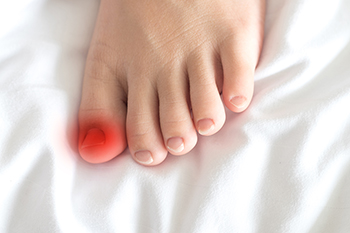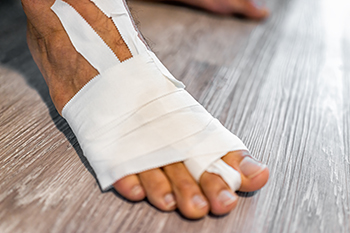Items filtered by date: June 2025
When Ingrown Toenails Need More Than Quick Fixes

An ingrown toenail is more than a surface problem. When the edge of the nail presses into the surrounding skin, it can become embedded like a splinter. The nail plate, once pushed into the soft tissue, is treated by the body as something that does not belong. This triggers swelling, pain, and redness as part of a natural inflammatory response. While soaking or trimming might ease discomfort temporarily, they rarely solve the deeper issue. Treatment that takes both the physical problem and personal preferences into account leads to better results. Some people respond well to careful conservative care, while others may need a minor in-office procedure to remove the piece of nail causing trouble. A podiatrist can explain the options and help choose the approach that works best for you. When discomfort continues or worsens, it is suggested that you schedule an appointment with a podiatrist for appropriate treatment.
Ingrown toenails can become painful if they are not treated properly. For more information about ingrown toenails, contact one of our podiatrists of North Penn Podiatry. Our doctors can provide the care you need to keep you pain-free and on your feet.
Ingrown Toenails
Ingrown toenails occur when a toenail grows sideways into the bed of the nail, causing pain, swelling, and possibly infection.
Causes
- Bacterial infections
- Improper nail cutting such as cutting it too short or not straight across
- Trauma to the toe, such as stubbing, which causes the nail to grow back irregularly
- Ill-fitting shoes that bunch the toes too close together
- Genetic predisposition
Prevention
Because ingrown toenails are not something found outside of shoe-wearing cultures, going barefoot as often as possible will decrease the likeliness of developing ingrown toenails. Wearing proper fitting shoes and using proper cutting techniques will also help decrease your risk of developing ingrown toenails.
Treatment
Ingrown toenails are a very treatable foot condition. In minor cases, soaking the affected area in salt or antibacterial soaps will not only help with the ingrown nail itself, but also help prevent any infections from occurring. In more severe cases, surgery is an option. In either case, speaking to your podiatrist about this condition will help you get a better understanding of specific treatment options that are right for you.
If you have any questions, please feel free to contact our offices located in Lansdale, and King of Prussia, PA . We offer the newest diagnostic and treatment technologies for all your foot care needs.
Managing a Stress Fracture

A foot stress fracture is a tiny crack in the bone, often caused by repetitive force or overuse, and is most commonly found in the toes, midfoot, or heel. It typically starts with dull, aching pain that gradually worsens with activities like walking, running, or standing for long periods. The pain is usually focused on one specific spot and may feel mild at first, leading many people to overlook it. What makes a stress fracture tricky is that it usually does not cause visible swelling or bruising, unlike other injuries. As the fracture progresses, the pain may become sharp and more limiting, interfering with everyday movement. A podiatrist can diagnose a stress fracture through imaging tests, such as X-rays or MRIs. Treatment usually involves reducing weight or pressure through crutches, a walking boot, or rest. In rare cases, surgery may be necessary if the fracture does not heal properly. If you suspect a stress fracture, it is suggested that you schedule an appointment with a podiatrist for a proper diagnosis and appropriate care.
Activities where too much pressure is put on the feet can cause stress fractures. To learn more, contact one of our podiatrists from North Penn Podiatry. Our doctors can provide the care you need to keep your pain free and on your feet.
Dealing with Stress Fractures of the Foot and Ankle
Stress fractures occur in the foot and ankle when muscles in these areas weaken from too much or too little use. The feet and ankles then lose support when walking or running from the impact of the ground. Since there is no protection, the bones receive the full impact of each step. Stress on the feet can cause cracks to form in the bones, thus creating stress fractures.
What Are Stress Fractures?
Stress fractures occur frequently in individuals whose daily activities cause great impact on the feet and ankles. Stress factors are most common among:
- Runners
- People affected with Osteoporosis
- Tennis or basketball players
- Gymnasts
- High impact workouts
Symptoms
Pain from the fractures occur in the area of the fractures and can be constant or intermittent. It will often cause sharp or dull pain with swelling and tenderness. Engaging in any kind of activity which involves high impact will aggravate pain.
If you have any questions please contact our offices located in Lansdale, and King of Prussia, PA . We offer the newest diagnostic and treatment technologies for all your foot and ankle needs.
Types and Symptoms of Turf Toe

Turf toe is a sprain of the metatarsophalangeal, or MTP, joint, which connects the base of the big toe to the foot. This injury typically occurs when the big toe bends upward beyond its normal range, damaging the surrounding ligaments and tissues of the plantar complex. Symptoms of turf toe include pain, swelling, bruising, and reduced ability to push off with the toe. Turf toe injuries are grouped into three categories. Grade 1 involves stretching of the soft tissue, resulting in mild tenderness. Grade 2 involves a partial tear, causing more pain, swelling, and limited joint movement. Grade 3 is the most severe, with a complete tear of the soft tissue, often preventing weight-bearing on the toe. Turf toe is frequently experienced by athletes who play on artificial surfaces, especially those who wear lightweight shoes. It can affect gymnasts, dancers and other active people, as well. If you have symptoms of a turf toe injury, it is suggested that you schedule an appointment with a podiatrist for an exam and appropriate treatment options.
Toe pain can disrupt your daily activities. If you have any concerns, contact one of our podiatrists of North Penn Podiatry. Our doctors can provide the care you need to keep you pain-free and on your feet.
What Causes Toe Pain?
Most severe toe pain is caused due to a sports injury, trauma from dropping something heavy on the toe, or bumping into something rigid. Other problems can develop over time for various reasons.
Toe pain can be caused by one or more ailments. The most common include:
- Trauma
- Sports injury
- Wearing shoes that are too tight
- Arthritis
- Gout
- Corns and calluses
- Hammertoe
- Bunions
- Blisters
- Ingrown toenails
- Sprains
- Fractures (broken bones)
- Dislocations
When to See a Podiatrist
- Severe pain
- Persistent pain that lasts more than a week
- Signs of infection
- Continued swelling
- Pain that prevents walking
Diagnosis
In many cases the cause of toe pain is obvious, but in others, a podiatrist may want to use more advanced methods to determine the problem. These can range from simple visual inspections and sensation tests to X-rays and MRI scans. Prior medical history, family medical history, and any recent physical traumatic events will all be taken into consideration for a proper diagnosis.
Treatment
Treatments for toe pain and injuries vary and may include shoe inserts, padding, taping, medicines, injections, and in some cases, surgery. If you believe that you have broken a toe, please see a podiatrist as soon as possible.
If you have any questions please contact our offices located in Lansdale, and King of Prussia, PA . We offer the newest diagnostic and treatment technologies for all your foot and ankle needs.
Nerve Pain in the Foot

Nerve pain in the foot can result from several conditions, including a pinched nerve, tarsal tunnel syndrome, or peripheral neuropathy. A pinched nerve can occur from foot structure issues or injury, causing sharp or shooting pain. Tarsal tunnel syndrome is similar to carpal tunnel in the wrist and involves compression of the posterior tibial nerve near the ankle. Peripheral neuropathy, often linked to diabetes, involves nerve damage and can affect both feet. Symptoms may include tingling, burning, numbness, or a stabbing sensation. The foot may feel weak, sensitive to touch, or asleep. These symptoms can interfere with walking or even standing. A podiatrist can diagnose the underlying cause through physical exams, imaging, or nerve testing. Treatment options include custom orthotics, anti-inflammatory medication, targeted exercises, corticosteroid injections, or surgery, in severe cases. Managing underlying conditions like diabetes is also critical. If you have symptoms of foot nerve pain, it is suggested that you schedule an appointment with a podiatrist for appropriate treatment solutions.
Foot Pain
Foot pain can be extremely painful and debilitating. If you have a foot pain, consult with one of our podiatrists from North Penn Podiatry. Our doctors will assess your condition and provide you with quality foot and ankle treatment.
Causes
Foot pain is a very broad condition that could be caused by one or more ailments. The most common include:
- Bunions
- Hammertoes
- Plantar Fasciitis
- Bone Spurs
- Corns
- Tarsal Tunnel Syndrome
- Ingrown Toenails
- Arthritis (such as Gout, Rheumatoid, and Osteoarthritis)
- Flat Feet
- Injury (from stress fractures, broken toe, foot, ankle, Achilles tendon ruptures, and sprains)
- And more
Diagnosis
To figure out the cause of foot pain, podiatrists utilize several different methods. This can range from simple visual inspections and sensation tests to X-rays and MRI scans. Prior medical history, family medical history, and any recent physical traumatic events will all be taken into consideration for a proper diagnosis.
Treatment
Treatment depends upon the cause of the foot pain. Whether it is resting, staying off the foot, or having surgery; podiatrists have a number of treatment options available for foot pain.
If you have any questions, please feel free to contact our offices located in Lansdale, and King of Prussia, PA . We offer the newest diagnostic and treatment technologies for all your foot care needs.
